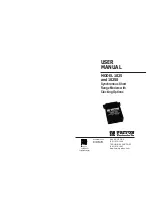
COMMAND RANGING & TELEMETRY UNIT CORTEX
Is.Rev.
Date:
© Safran Data Systems
This document is the property of
Safran Data Systems
.
It cannot be duplicated or distributed without expressed written consent.
Page 106
Figure 48: Constellation of the received signal with DEAF activated
3.3.15.2.1.Configuration of the DEAF Algorithm
Several parameters are available for configuring the DEAF algorithm. They can be found in the STI 100013_TTC
(TMU monitoring and control table). They are the following:
The DEAF algorithm can be turned on and off. Once the algorithm is turned on, it can be
turned off without restarting the signal acquisition. That means that when the user is
satisfied with the solution achieved, the algorithm can be stopped.
The speed of the algorithm can be set to fast or slow.
The impulse response of the adaptive filter can be forced to be symmetric.
The impulse response of the adaptive filter can be set to real or complex.
The filter to which the algorithm converges can be saved in a set of custom filters. This feature avoids waiting for
the algorithm to converge at each signal reacquisition. In fact, if the IFR is restarted, or if the PLL unlocks, the
DEAF algorithm stops and the matched filter is reinitialized.
The filter with which the algorithm is initialized can be chosen among the ones listed in the TMU table. They are
Integrate and Dump filter, Raised cosine filter, Root raised cosine filter, or a custom filter.
Custom filters are saved in a folder specific to each TMU. The path to this folder is chosen in the registry
key
HKEY_LOCAL_MACHINE\SOFTWARE\In-snec\CortexCRT\SetDefaultN\Preferences\TmuX\DEAFFirPath
















































